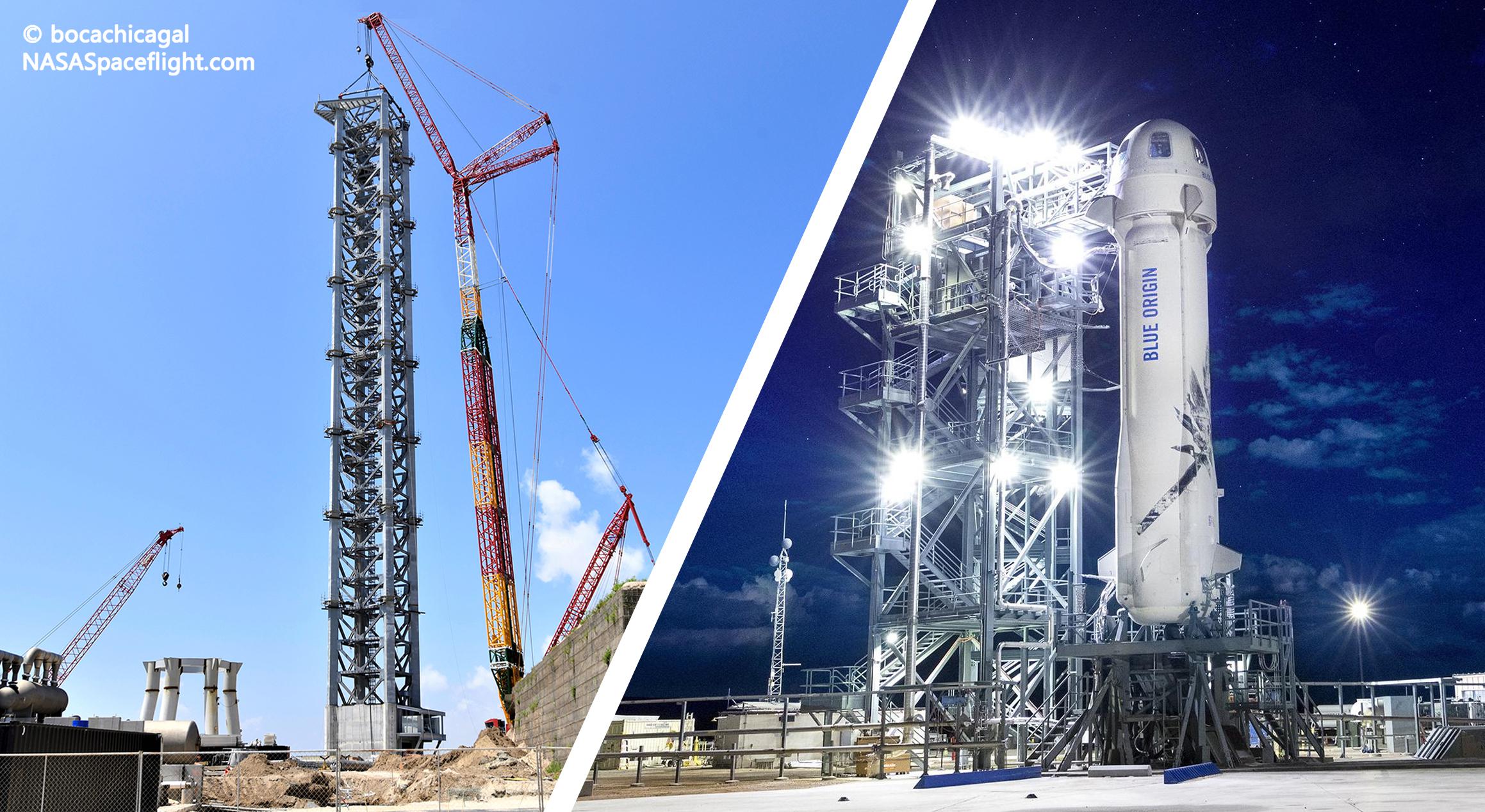
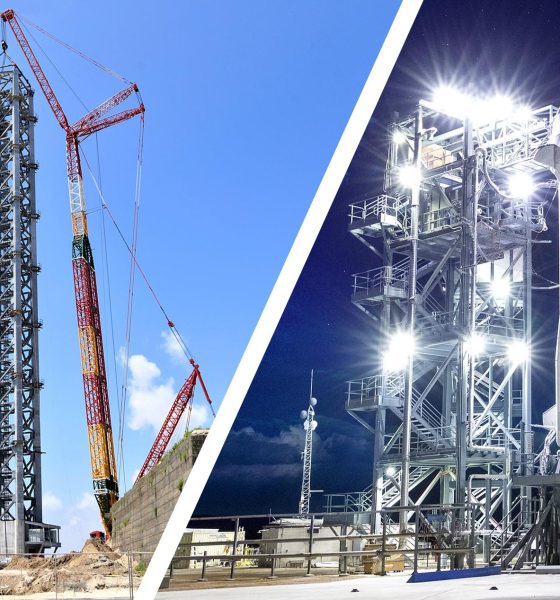
News
SpaceX tops off Starship launch tower during Blue Origin crew launch briefing
On Sunday morning, SpaceX began the process of installing the last prefabricated section of Starship’s skyscraper-sized ‘launch tower’ around the same time as startup Blue Origin kicked off a preflight briefing for its first crewed suborbital launch.
Though both events are almost entirely unconnected and have no immediate impact on each other, the simultaneity almost immediately triggered comparisons between one of the most important media briefings in Blue Origin’s 21-year history and an average busy day at SpaceX’s South Texas Starship factory and launch site. Almost exclusively funded by Amazon founder and CEO Jeff Bezos since it was founded in September 2000, around two years before SpaceX, Blue Origin is on the cusp of its first crewed launch less than two weeks after Virgin Galactic completed its first fully-crewed test flight above 80 km (~50 mi).
Approximately 600 miles southeast of Blue Origin’s Van Horn, Texas launch and test facilities, in a different corner of the vast state, SpaceX was preparing for the latest in a long line of steps towards the completion of an orbital launch site for Starship – potentially the first fully reusable orbital rocket ever built.
First revealed more than three months ago in a cryptic post from owner Jeff Bezos, Blue Origin is scheduled to launch passengers on its New Shepard rocket for the first time ever, marking the end of an extraordinarily long development period. Designed to be fully reusable, New Shepard is a small single-stage rocket powered by one liquid hydrogen and oxygen-fueled BE-3 engine capable of producing approximately 500 kN (110,000 lbf) of thrust at liftoff. Designed exclusively for the purpose of ferrying a few tourists above a mostly arbitrary 100 km (~62 mi) line separating Earth’s atmosphere and “space,” New Shepard is about the same diameter as SpaceX’s Falcon 9 and Falcon Heavy rockets but is just 15m (~50 ft) tall.
The small rocket launched for the first time in April 2015 and reached an apogee of ~94 km but instability ultimately destroyed the first New Shepard booster during its first landing attempt. Blue Origin successfully launched and landed New Shepard on its next test flight in November 2015, culminating in Bezos’ infamous “Welcome to the club!” comment after SpaceX successfully recovered a Falcon 9 booster for the first time one month later.
As of July 2021, Blue Origin has completed just 15 New Shepard test flights – 14 of which were fully successful – in six years. In the same period, SpaceX successfully recovered an orbital-class Falcon 9 booster for the first time, reused a Falcon booster on a commercial satellite launch, debuted Falcon Heavy, reused several orbital Cargo Dragon capsules three times each, debuted Crew Dragon, became the first company in history to launch astronauts, completed its first operational astronaut launch for NASA, hopped three Starship prototypes, flew five Starship prototypes to 10-15 km, successfully landed four Raptor-powered Starship prototypes, rolled out Starship’s first completed booster prototype, completed more than 100 successful orbital launches, flown the same Falcon 9 booster ten times (versus New Shepard’s record of seven flights), reused orbital-class boosters 68 times, created the world’s largest satellite constellation, and far, far more.
Along those lines, on Saturday, July 17th, SpaceX teams attached a massive crane to the seventh prefabricated section of a ‘launch tower’ that could eventually support Starship and Super Heavy stacking – and maybe even catch ships and boosters. On Sunday, not long after daybreak and about an hour before Blue Origin’s New Shepard-16 preflight briefing, that tower section lifted off under the watchful eye of several unofficial cameras operated by NASASpaceflight, LabPadre, and others. By the end of Blue Origin’s briefing, most of which involved executives or senior employees reading from scripts and none of which offered a look at actual flight hardware or “astronaut” preparations, the eighth launch tower section was mostly in place, creating a structure some 135m (~440 ft) tall.
By the end of NASASpaceflight.com’s unofficial six-hour stream, the outlet’s excellent and unaffiliated coverage of SpaceX erecting part of a relatively simple tower for the seventh time had been viewed more than a quarter of a million times. By the end of Blue Origin’s official preflight briefing for a crewed launch set to carry the richest person on Earth, the company had accrued around 20,000 views on YouTube.
Some might see ten times as many viewers flocking to an unofficial live stream of fairly mundane SpaceX construction over a briefing for the first crewed launch of a fully-reusable suborbital rocket and scoff. For those who watched both broadcasts, it’s likely less than shocking that spaceflight and rocket fans almost universally sided with a livestream showing something – anything! – happening over what amounted to a camera pointed at five people reading (mostly stale) statements off of teleprompters.
Barely 24 hours away from Blue Origin’s most significant launch ever, the company – save for a few low-res clips from Jeff Bezos – has yet to share a single new piece of media highlighting the mission’s actual New Shepard rocket, crew capsule, astronaut preparations, flight suits, launch pad, or any of the other dozens of things most spaceflight fans – and people in general – tend to get excited about. For whatever reason, Blue Origin has also worked with Texas to shut down the only quasi-public viewing area less than 10-20 miles away from New Shepard’s launch pad despite never having done so in 15 test flights.
SpaceX, on the other hand, may not have always been a perfect neighbor in Boca Chica but the company has mostly accepted the buzzing, near-continuous presence of spaceflight fans and members of the media who come to South Texas to see Starbase in person. More recently, SpaceX has actively let at least two media outlets (NASASpaceflight and LabPadre) install and operate several robotic cameras overlooking Boca Chica’s Starship factory and pad.
It’s impossible to condense it into one or two simple differences but it’s safe to say that SpaceX’s relative openness and a general willingness to engage with media and let public excitement and interest grow uninterrupted (when possible) is part of the reason that mundane SpaceX goings-on can accumulate a magnitude more interest on unofficial channels than an official briefing for the most important event in Blue Origin’s history.

Elon Musk
Elon Musk proposes Grok 5 vs world’s best League of Legends team match
Musk’s proposal has received positive reception from professional players and Riot Games alike.

Elon Musk has proposed a high-profile gaming challenge for xAI’s upcoming Grok 5. As per Musk, it would be interesting to see if the large language model could beat the world’ best human League of Legends team with specific constraints.
Musk’s proposal has received positive reception from professional players and Riot Games alike, suggesting that the exciting exhibition match might indeed happen.
Musk outlines restrictions for Grok
In his post on X, Musk detailed constraints to keep the match competitive, including limiting Grok to human-level reaction times, human-speed clicking, and viewing the game only through a camera feed with standard 20/20 vision. The idea quickly circulated across the esports community, drawing commentary from former pros and AI researchers, as noted in a Dexerto report.
Former League pro Eugene “Pobelter” Park expressed enthusiasm, offering to help Musk’s team and noting the unique comparison to past AI-versus-human breakthroughs, such as OpenAI’s Dota 2 bots. AI researcher Oriol Vinyals, who previously reached Grandmaster rank in StarCraft, suggested testing Grok in RTS gameplay as well.
Musk welcomed the idea, even responding positively to Vinyals’ comment that it would be nice to see Optimus operate the mouse and keyboard.
Pros debate Grok’s chances, T1 and Riot show interest
Reactions weren’t universally optimistic. Former professional mid-laner Joedat “Voyboy” Esfahani argued that even with Grok’s rapid learning capabilities, League of Legends requires deep synergy, game-state interpretation, and team coordination that may be difficult for AI to master at top competitive levels. Yiliang “Doublelift” Peng was similarly skeptical, publicly stating he doubted Grok could beat T1, or even himself, and jokingly promised to shave his head if Grok managed to win.
T1, however, embraced the proposal, responding with a GIF of Faker and the message “We are ready,” signaling their willingness to participate. Riot Games itself also reacted, with co-founder Marc Merrill replying to Musk with “let’s discuss.” Needless to say, it appears that Riot Games in onboard with the idea.
Though no match has been confirmed, interest from players, teams, and Riot suggests the concept could materialize into a landmark AI-versus-human matchup, potentially becoming one of the most viewed League of Legends events in history. The fact that Grok 5 will be constrained to human limits would definitely add an interesting dimension to the matchup, as it could truly demonstrate how human-like the large language model could be like in real-time scenarios.
Tesla has passed a key milestone, and it was one that CEO Elon Musk initially mentioned more than nine years ago when he published Master Plan, Part Deux.
As per Tesla China in a post on its official Weibo account, the company’s Autopilot system has accumulated over 10 billion kilometers of real-world driving experience.
Tesla China’s subtle, but huge announcement
In its Weibo post, Tesla China announced that the company’s Autopilot system has accumulated 10 billion kilometers of driving experience. “In this respect, Tesla vehicles equipped with Autopilot technology can be considered to have the world’s most experienced and seasoned driver.”
Tesla AI’s handle on Weibo also highlighted a key advantage of the company’s self-driving system. “It will never drive under the influence of alcohol, be distracted, or be fatigued,” the team wrote. “We believe that advancements in Autopilot technology will save more lives.”
Tesla China did not clarify exactly what it meant by “Autopilot” in its Weibo post, though the company’s intense focus on FSD over the past years suggests that the term includes miles that were driven by FSD (Beta) and Full Self-Driving (Supervised). Either way, 10 billion cumulative miles of real-world data is something that few, if any, competitors could compete with.
Advertisement
–>
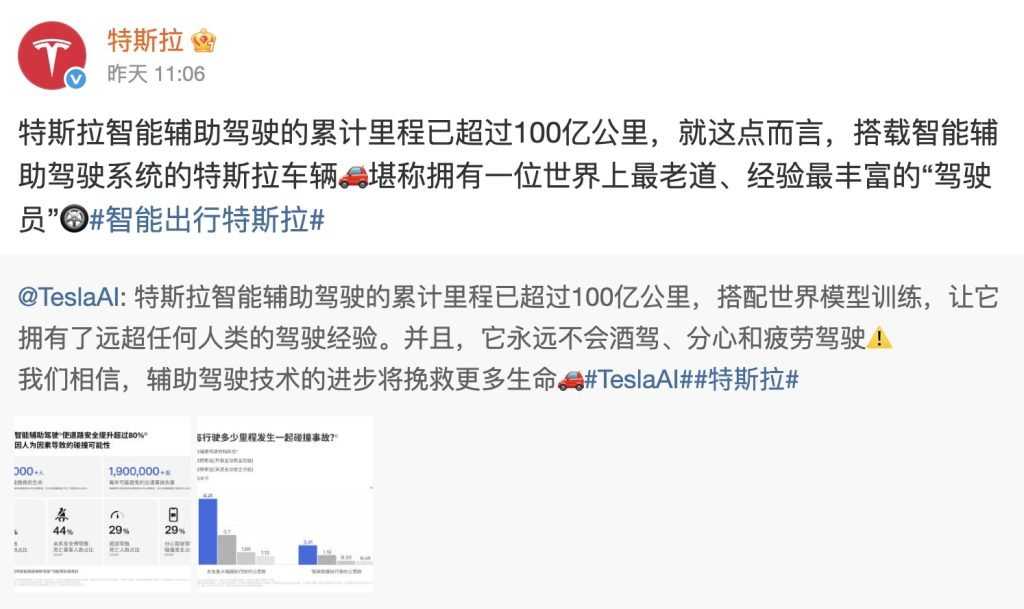
Elon Musk’s 10-billion-km estimate, way back in 2016
When Elon Musk published Master Plan Part Deux, he outlined his vision for the company’s autonomous driving system. At the time, Autopilot was still very new, though Musk was already envisioning how the system could get regulatory approval worldwide. He estimated that worldwide regulatory approval will probably require around 10 billion miles of real-world driving data, which was an impossible-sounding amount at the time.
“Even once the software is highly refined and far better than the average human driver, there will still be a significant time gap, varying widely by jurisdiction, before true self-driving is approved by regulators. We expect that worldwide regulatory approval will require something on the order of 6 billion miles (10 billion km). Current fleet learning is happening at just over 3 million miles (5 million km) per day,” Musk wrote.
It’s quite interesting but Tesla is indeed getting regulatory approval for FSD (Supervised) at a steady pace today, at a time when 10 billion miles of data has been achieved. The system has been active in the United States and has since been rolled out to other countries such as Australia, New Zealand, China, and, more recently, South Korea. Expectations are high that Tesla could secure FSD approval in Europe sometime next year as well.
News
Elon Musk’s Boring Company reveals Prufrock TBM’s most disruptive feature
As it turns out, the tunneling startup, similar to other Elon Musk-backed ventures, is also dead serious about pursuing reusability.
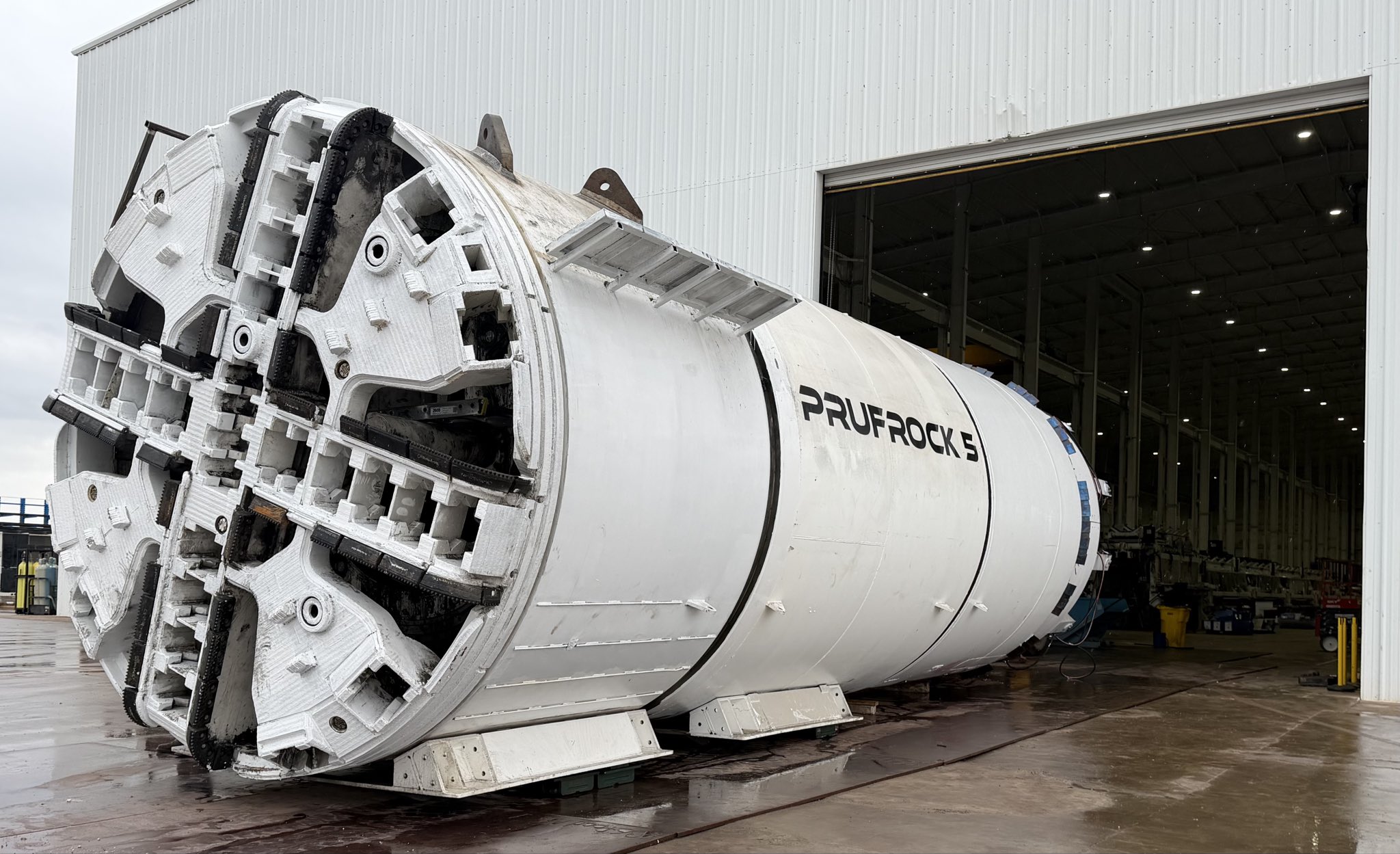
The Boring Company has quietly revealed one of its tunnel boring machines’ (TBMs) most underrated feature. As it turns out, the tunneling startup, similar to other Elon Musk-backed ventures, is also dead serious about pursuing reusability.
Prufrock 5 leaves the factory
The Boring Company is arguably the quietest venture currently backed by Elon Musk, inspiring far fewer headlines than his other, more high-profile companies such as Tesla, SpaceX, and xAI. Still, the Boring Company’s mission is ambitious, as it is a company designed to solve the problem of congestion in cities.
To accomplish this, the Boring Company would need to develop tunnel boring machines that could dig incredibly quickly. To this end, the startup has designed Prufrock, an all-electric TBM that’s designed to eventually be fast enough as an everyday garden snail. Among TBMs, such a speed would be revolutionary.
The startup has taken a step towards this recently, when The Boring Company posted a photo of Prufrock-5 coming out of its Bastrop, Texas facility. “On a rainy day in Bastrop, Prufrock-5 has left the factory. Will begin tunneling by December 1. Hoping for a step function increase in speed,” the Boring Company wrote.
Prufrock’s quiet disruption
Interestingly enough, the Boring Company also mentioned a key feature of its Prufrock machines that makes them significantly more sustainable and reusable than conventional TBMs. As per a user on X, standard tunnel boring machines are often left underground at the conclusion of a project because retrieving them is usually more expensive and impractical than abandoning them in the location.
As per the Boring Company, however, this is not the case for its Prufrock machines, as they are retrieved, upgraded, and deployed again with improvements. “All Prufrocks are reused, usually with upgrades between launches. Prufrock-1 has now dug six tunnels,” the Boring Company wrote in its reply on X.
The Boring Company’s reply is quite exciting as it suggests that the TBMs from the tunneling startup could eventually be as reusable as SpaceX’s boosters. This is on brand for an Elon Musk-backed venture, of course, though the Boring Company’s disruption is a bit more underground.
News
Tesla accused of infringing robotics patents in new lawsuit
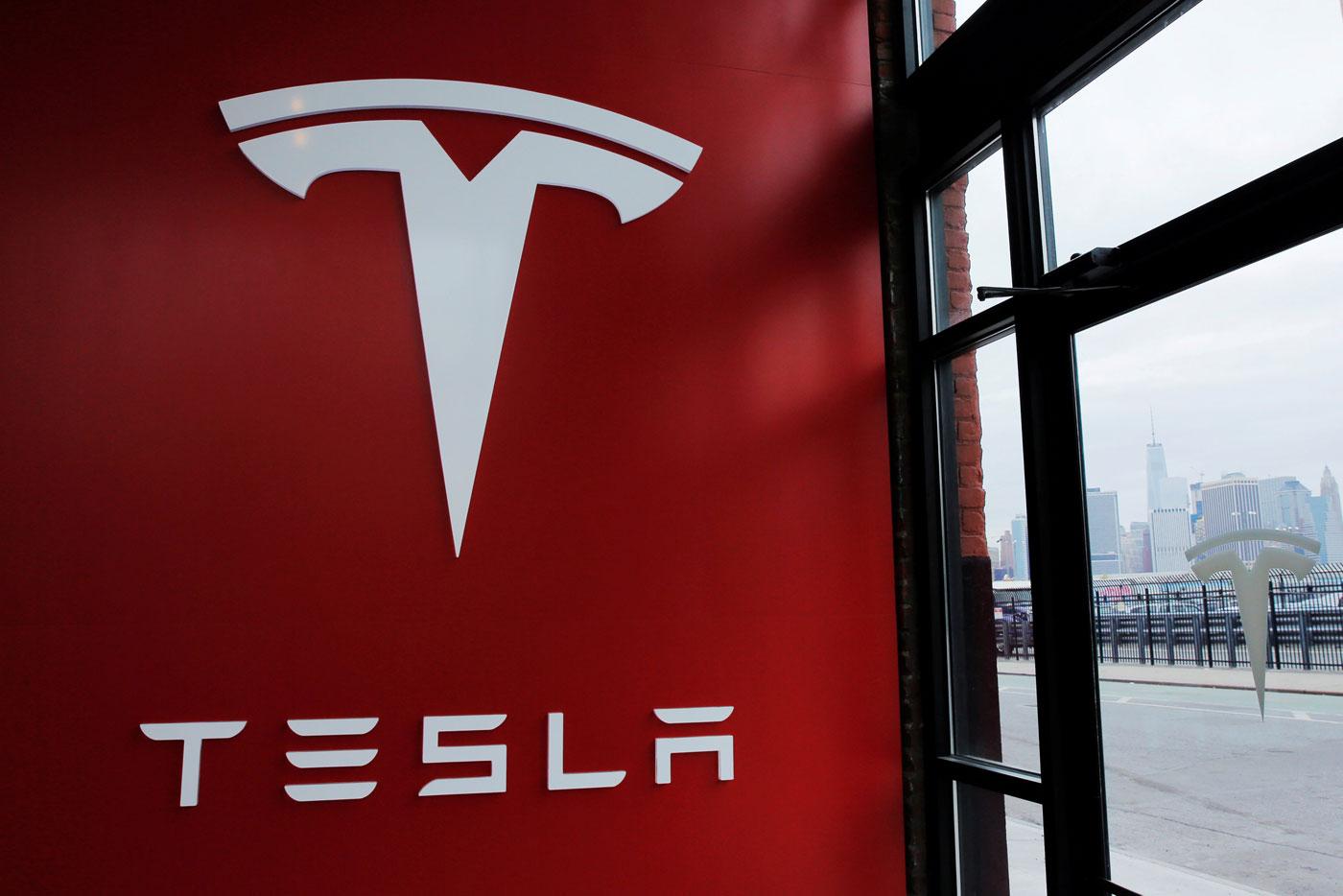
Tesla is being accused of infringing robotics patents by a company called Perrone Robotics, which is based out of Charlottesville, Virginia.
The suit was filed in Alexandria, Virginia, and accuses Tesla of knowingly infringing upon five patents related to robotics systems for self-driving vehicles.
The company said its founder, Paul Perrone, developed general-purpose robotics operating systems for individual robots and automated devices.
Perrone Robotics claims that all Tesla vehicles utilizing the company’s Autopilot suite within the last six years infringe the five patents, according to a report from Reuters.
Tesla’s new Safety Report shows Autopilot is nine times safer than humans
One patent was something the company attempted to sell to Tesla back in 2017. The five patents cover a “General Purpose Operating System for Robotics,” otherwise known as GPROS.
The GPROS suite includes extensions for autonomous vehicle controls, path planning, and sensor fusion. One key patent, U.S. 10,331,136, was explicitly offered to Tesla by Perrone back in 2017, but the company rejected it.
The suit aims to halt any further infringements and seeks unspecified damages.
This is far from the first suit Tesla has been involved in, including one from his year with Perceptive Automata LLC, which accused Tesla of infringing on AI models to interpret pedestrian/cyclist intent via cameras without licensing. Tesla appeared in court in August, but its motion to dismiss was partially denied earlier this month.
Tesla also settled a suit with Arsus LLC, which accused Autopilot’s electronic stability features of infringing on rollover prevention tech. Tesla won via an inter partes review in September.
Most of these cases involve non-practicing entities or startups asserting broad autonomous vehicle patents against Tesla’s rapid iteration.
Tesla typically counters with those inter partes reviews, claiming invalidity. Tesla has successfully defended about 70 percent of the autonomous vehicle lawsuits it has been involved in since 2020, but settlements are common to avoid discovery costs.
The case is Perrone Robotics Inc v Tesla Inc, U.S. District Court, Eastern District of Virginia, No. 25-02156. Tesla has not yet listed an attorney for the case, according to the report.








